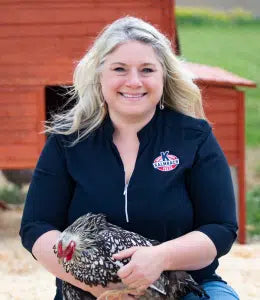The Scoop on Fermenting Chicken Feed

Fermenting chicken feed has been a hot topic for a few years now. I get asked about it a lot, so let’s dive into what fermentation is and the pros and cons.
What is Fermented Chicken Feed?
First, I think there is often confusion on what it actually means to ferment. The definition of fermentation is a chemical process by which molecules are broken down anaerobically. This process usually changes the pH of a substance and is often used to preserve food or convert sugars to alcohol. I have always felt like “fermenting” was a bit of a misnomer in context and, in many cases, people are simply just soaking feed.
What are the Pros and Cons of Fermenting Feed?
Pros
There is a common acceptance that fermenting feed can significantly reduce the amount of feed that is needed. However, the benefits of fermentation are heavily dependent on proper technique. Proper technique requires achieving correct levels of lactic and acetic acid, resulting in a pH of 4.5. If you are simply soaking your feed, the risks of using wet feed outweigh any potential benefit.
Research has shown that broiler chickens fed a feed that is simply soaked in water had lower feed intake and lower body weights compared to broilers fed a dry feed1. However, if fermentation is conducted correctly and the pH of the finished product is properly reduced, there is evidence that chickens can gain more weight1 when fed a fermented feed. Proper feed fermentation can also result in the growth of beneficial bacteria and reduces the pH in the gut, which can help fight the negative effects of bad bacteria.
Cons
There are definite risks to fermenting feed, and I believe it is very important to consider if the reward outweighs the potential risk. The primary risk to adding water to any feed is mold growth. This is why technique is so important. Without a proper drop in pH, adding water to feed makes it a prime environment for mold growth. More dangerous than mold is a sneaky group of toxins that can be produced – mycotoxins! Mycotoxins are invisible and have no smell. Even if you do not see mold, that doesn’t mean that mycotoxins aren’t already being produced. Keeping your feed dry and stored in a cool environment is the best way to prevent mold and mycotoxins.
Remember, the benefits of fermentation are heavily dependent on proper technique and this includes any benefit you get to the nutrient value of the feed. Most university-level research points to improvements in nutrient values, but these changes are often pretty small. Are these rewards worth the risk for you? A comparison of available crude protein and energy in a laying feed showed an increase in crude protein (~3%; Note- this is 3% NOT 3 percentage points), but no change in energy for a properly fermented feed compared to a dry feed2. There was also a decrease in the essential amino acids Lysine (6%) and Threonine (3%) in the fermented feed. On a positive note, it appears that properly fermenting feeds does decrease the amount of phytate-bound phosphorus by nearly 30%2. Releasing bound phosphorus is important for bone development and really important for the environment.
In conclusion, there are some benefits to fermenting feed. However, it is extremely important to consider the risk vs. the reward. The benefits of fermenting feed are heavily dependent on proper technique. Mold and mycotoxin growth in feeds can be very dangerous. There are also some nutrients, primarily vitamins, that are susceptible to degradation with moisture and heat. If you aren’t using proper technique, you could be doing more harm than good.
References
- Chen, K.L., W.L. Kho, S.H. You, R.H. Yeh, S.W. Tang, and C.W. Hsieh. 2009. Effects of Bacillus subtilis var. natto and Saccharomyces cerevisiae mixed fermented feed on the enhanced growth performance of broilers. Poult. Sci. 88:309-315.
- Engberg, R.M., M. Hommershoj, M.S. Abousekken, S. Steenfeldt, and B.B. Jensen. 2009. Fermented feed for laying hens: effects on egg production, egg quality, plumage condition and composition and activity of the intestinal microflora. Br. Poult. Sci. 50:228-239.
